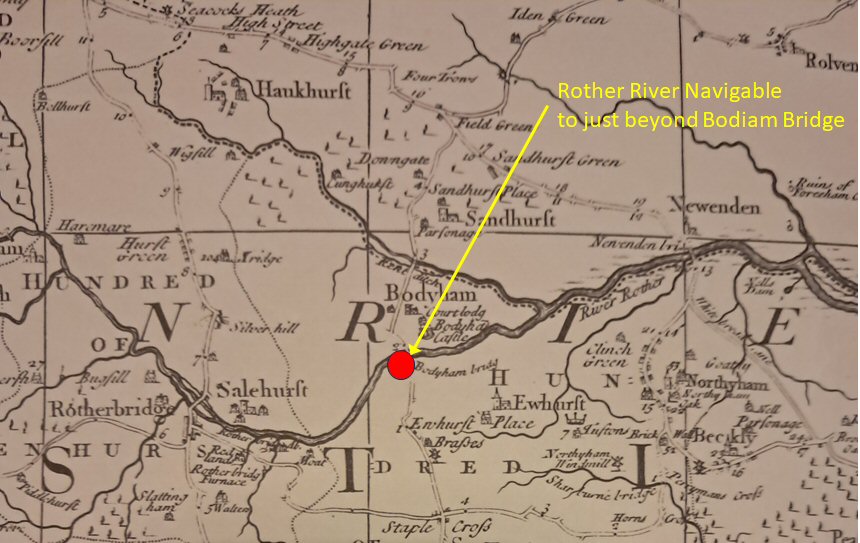|
 | Anglo Saxon History |  | |
| | Tidebrook near Wadhurst could it have been tidal ?? |
|---|
My current theory on Saxon Place Names
I have was looking at the place names around Hastings, which all appear to be Saxon, with a very few exceptions.
My research leads me to conclude that this area was settled between the take over of Kent by Henghest and Horsa, and the
take over of the South Downs area by Aelle, so around 465AD.
As a lot of villages have similar snippets in their name and I wondered if each of these meant something, and that this
in turn might mean that the settlement names described the use or surroundings of a place.
So what could these snippets mean ??
My conclusions may seem surprising but please read ~~link~Snippet 1 - what is an island, eye etc ~snippet_eye~~ before
reading any other snippet pages as this explains the reason for the '4.5 metre line' described in other snippets.
| | |
|---|
| Tidebrook |
|---|
It is unlikely that you have heard of Tidebrook unless you live near Wadhurst or Mayfield in East Sussex.
Tidebrook is a Saxon name that is made up of Tide derived from tyd - time - meaning regular and
brook derived from broc - a brook or stream
I have always been fascinated by the name of this location as it implies that the River Rother was tidal all the way up
to this location in early Saxon Times.
| 
This is a Google My Maps showing the location of Tidebrook, which is a stream that rises near Mark Cross in East Sussex,
so how could it be possible for the tides to reach here ?
The point where the Tidebrook reaches the Rother is about 27 miles inland from the current mouth of the Eastern Rother
which is at Rye. The hamlet of Tidebrook is a further 3 miles (5Km) further upstream, and its source is a further 2.2
miles (3.6Km) upstream.
It is very unlikely that the stream could have been tidal up to the Hamlet of Tidebrook, so we will try to analyse
whether it's possible for the tide to carry on up the Rother to the place where the Tidebrook joins the Rother which
currently lies about 29 metres higher than the OD (Ordnance Datum - Average tide level).
| | Navigation in the River Rother |
|---|
The river Rother is currently only tidal to the lock at Scots Float Sluice, also known as Star Lock just north of Rye,
this was probably built in the late 1600s as there are records of repairs being carried out in 1723.
However there were two Acts of Parliament passed in 1826 and 1830 that refer to this area, they are known as the Rother
Levels Acts.
These acts primarily focused on ensuring navigation on the River Rother between Scots Float and Bodiam Bridge,
specifically requiring a minimum of 5 feet of headroom under bridges. The Acts also dealt with managing the low-lying
land (Rother Levels) through which the river flows, likely for drainage and agricultural purposes.
|
Navigation to Bodiam
|
|---|

The map above was produced by Richard Budgen, and drawn in 1724 showing the navigation to Bodiam.
In this context it would imply that the Rother was tidal to at least Bodiam, and allowed for seagoing vessels with a
draft of about 2 metres. the Rother at Bodiam is currently at about 5 metres O.D.
The Robertsbridge Furnace at this time was producing iron bar and cannon balls, so these were probably being carried by
barge down to the Bodiam or Newenden where they would be transshipped to sea going vessels, however this implies that
the Rother at Robertbridge would also have been salt water at high tide times. Robertsbridge is about 8 metres O.D.
| | |
|---|
| The Romans in this area |
|---|
Recent excavations at Bodiam by the Robertsbridge Archaeological Society have unearthed a Roman Port on the South Bank
of the Rother near the current level crossing for the Kent & East Sussex Steam Railway, with a causeway from the North
Bank coming over to the Port, and most likely a moveable bridge for the final stretch over the river to the South bank.
This port was most likely a Sea Port where shallower depth barges headed west towards Etchingham and Stonegate, where
one of the larger Roman iron working plants was located in an area called Bardown. This translates from the Saxon as
either the bear or boar fort, probably originated by the Celts.
The River Rother's height above Ordnance Datum (OD) is 2.225 meters at Bodiam.
Tidebrook is only about 1.5 miles(2.4 Km) from the Bardown ironworks.
|
|
|
|
|
|
|
| |
|
|
Local Interest
Just click an image |
|
|
|
|
|
|
|
|
|
|
|
|
| |
|
|